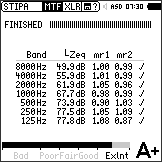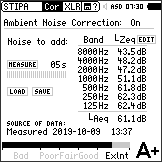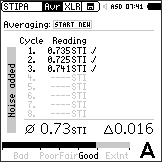Measure the typical background noise
The background noise level is measured under typical conditions, i.e. in the presence of a crowd. The LAeq is recorded for 30 seconds (or more) and saved in octave resolution. If an unusual, loud noise occurs during this measurement, the measurement must be rejected and repeated.
STI Measurement
The STI measurement itself ideally takes place when the location is empty e.g. at night.
Note: in certain places - e.g. a smaller train station in the middle of a residential area - it may not be possible to carry out STI measurements at night, as this would disturb the nearby residents. In such cases, the STI measurement takes place during the day, i.e. in the normal operating environment, and no correction of the STI result with a previously-recorded background noise level is necessary.
The STI test signal can be reproduced in two ways:
- With an audio cable into the existing PA system. e.g. use the MR-PRO signal generator
(Note: CD or MP3 players are less suitable because they have fluctuations in the sampling rate or can change the test signal through compression, which in turn negatively affects the measurement result).
- Acoustically from a dedicated loudspeaker, e.g. the NTi Audio TalkBox, which reproduces the test signal with a calibrated sound level of 60 dB at a distance of 1 m (the normal human speaking level). This solution is used wherever announcements are usually made through a microphone, or in places where the speech signal is not amplified electro-acoustically, e.g. in classrooms.
If a PA system is used for announcements, the next step is to adjust the volume in the public area. This should be measured at least at 6 dB, but better 10-18 dB above the usual background noise level. It should be noted that if the announcement level is too loud (over 80 dB) speech intelligibility will likely decrease.
Finally, STI values should be taken at several measurement positions; namely wherever people are usually located. The measuring points must be at a reasonable distance from one another in order to obtain a representative result. An individual STIPA measurement take 15 seconds per position. The measurements are averaged to a single result for the entire room.
Examining the Results
The plausibility of each individual result obtained must be checked. This identifies invalid measurements, e.g. due to impulsive ambient noise. The following errors can occur:
- Invalid modulation ratios in the individual octave bands (mr1 or mr2> 1.3)
- Fluctuating level relationships or impulsive conditions during the measurement (detected by comparing the first half of the measurement period with the second)
Note: advanced acoustic analyzers such as the XL2 perform this analysis and display the result automatically.

Analyzing the Results
The next step is to offset the measured STI results against the spectrum of the usual background noise. There are three methods available for this procedure:
- Direct measurement of speech intelligibility STI in a normal operating environment, i.e. in the presence of a crowd (see note in the above section “STI measurement”).
- Separately measure the typical ambient noise and add it to the measured STI value.
- Manually add a suitable set of predefined ambient noise data values (e.g. according to “Richtlinie des Österreichischen Bundesfeuerwehrverbandes”, TRVB S 1458).
Note: advanced acoustic analyzers such as the XL2 support each of these three methods and automatically calculate and display the result.

Averaging
Various standards determine how many times each measurement should be taken. The IEC 60268-16 standard, for example, recommends averaging at least three measured values at each measurement point, when in the presence of background noise. The deviation between any two of these three results must not be greater than 0.03 STI. The German VDE 0833-4 standard, on the other hand, requires a minimum of three measurements only if the first STI value is < 0.63.
Note: advanced acoustic analyzers such as the XL2 can independently perform this calculation and display the results.

Special Consideration
In emergencies, announcers tend to raise their voices and speak louder. This behavior is called the Lombard effect. To cover this situation, the acoustic input of the STI test signal can also be played at a level 10 dB higher. The TalkBox supports this application.